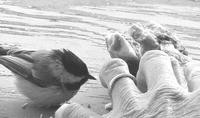|
The Sublette County Journal Volume 4, Number 27 - 3/2/00 brought to you online by Pinedale Online
It's been nearly six weeks since the little black-capped chickadee started visiting my kitchen windowsill, and whenever he makes his two-point landing and starts looking for handouts, it makes my daily dishwashing and cooking duties just that much more entertaining. Because the little fellow's feathers always look bent out of shape, I've named him Scruffy. At first, I thought he was puny, but a sick bird most likely won't live for six weeks, so I became convinced that the ragged little bird is just that - Scruffy. Out at the picnic table where I scatter wild birdseed, Scruffy's ragged appearance and unusually friendly nature apparently has made him the last boy in the pecking order as the more fit and frisky birds always drive him away. Here on my windowsill, however, Scruffy is the Big Boss. Yes, he has the whole spread to himself, because only Scruffy has the raw courage to share this ledge with my "barn" cat, Bugs Bunny. To avoid the cat's maw, Scruffy simply conducts a daily, mach one, reconnaissance, fly-by mission to determine whether or not the landing strip is safe. While the other aristocratic chickadees display their nervous acrobatics, Scruffy doesn't even bat an eye at what goes on in my kitchen. In fact, the more I clatter the pots and pans or thump the skillets on the edge of the chicken pail, the better the little fella seems to like it. He simply flitters across my hand, and settles hock-deep into the breadcrumbs or beef-bone smorgasbord. Then he leans back on his tail, grabs up a crust of bread in each "fist," and doesn't come up for air until the last crumb disappears down his scrawny throat. Because of Scruffy's unique behavior, I was curious about how "regular" chickadees are supposed to conduct business. The chickadee belongs to the group of birds known as titmice. The word titmouse comes from the Old Icelandic word, titr, meaning something small, and an old English word, mase, meaning small bird. Black-capped chickadees are year-round residents in Alaska, Canada, and the northern half of the U.S. Both the male and female have similar plumage, and they'll preen and scratch frequently, and bathe in water, snow, and dew. They consume a wide variety of foods including insect eggs, ants, beetles, aphids, millipedes, snails, and other small creatures. They also eat conifer seeds, goldenrod, ragweed, and wild fruit. At the feeder, black-capped chickadees are not very picky and will eat cornmeal, sunflower and pumpkin seeds, suet, and peanut butter. A non-migrating bird, they prefer to live in mixed hardwood-coniferous forests, but are also happy to homestead in small woodlands and shrubs in residential and ranchhouse areas.
Chickadees' predators are mainly hawks, owls, starvation, and barn cats. But, if Scruffy and Bugs keep successfully rotating windowsill shifts, Scruffy quite possibly could visit me for his entire life span of six to twelve years. In "Our Birds, Friend and Foe," I loved what William Athenton Dupuy said about Scruffy: "The little black-capped chickadee is the embodiment of cheerfulness, verve, and courage. It boasts no elegant plumes, and makes no claims as a songster, yet this blithe sprite is a distinctive character, and is a bird masterpiece beyond all praise. It is spruce and smart in its plain black, gray, and white livery; and its cheery, cordial notes are the 'open sesame' to woodland secrets." Photo credits: Cris Paravicini See The Archives for past articles. Copyright © 1999 The Sublette County Journal All rights reserved. Reproduction by any means must have permission of the Publisher. The Sublette County Journal, PO Box 3010, Pinedale, WY 82941 Phone 307-367-3713 Publisher/Editor: Rob Shaul editor@scjonline.com |

